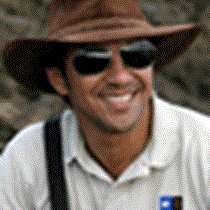Southern Isabela Island
It was shortly after breakfast when we started our exploration on southern Isabela. Bahía Urbina has an admirable amount of wildlife; this unfortunately means encounters with unwanted species such as wasps. This menace is a perfect example of why we should not introduce new species to ecosystems where they do not belong. Making this aware to others will not only prevent it from happening again in the Galápagos Islands, but in other regions as well.
Even before Darwin the islands were visited and exploited by whalers, pirates, buccaneers and privateers. These series of visits and the unawareness of what a special place these islands were, caused the introduction of all kinds of species that are considered nowadays “pests.” The diligent work from the National Park Service and the economic help of different private organizations has reflected on a much healthier ecosystem. Isabela Island and the path along Urbina Bay prove this to be true. Healthy populations of land iguanas are once again visible everywhere, showing their bright colors, which decades ago cost them their lives. There are no longer cats or dogs which were their main non-native predator, or goats, donkeys and cows who used to compete with them for their primary food of green leafs.
Although we did not see them today, Giant tortoises are coming back to the lowlands of the island due to the amount of food that is found on dry zones again.
The landscape deserved our attention too. Four of the six volcanoes on Isabela Island were very visible after a couple of weeks of heavy “volcanic fog” produced by the near eruption from Cerro Azul volcano.
We have been informed by the National Park that the eruption had ceased activity, but I can only hope to see one more time the orange-red glow in the distance, proof of the youth of this archipelago built from fire.
It was shortly after breakfast when we started our exploration on southern Isabela. Bahía Urbina has an admirable amount of wildlife; this unfortunately means encounters with unwanted species such as wasps. This menace is a perfect example of why we should not introduce new species to ecosystems where they do not belong. Making this aware to others will not only prevent it from happening again in the Galápagos Islands, but in other regions as well.
Even before Darwin the islands were visited and exploited by whalers, pirates, buccaneers and privateers. These series of visits and the unawareness of what a special place these islands were, caused the introduction of all kinds of species that are considered nowadays “pests.” The diligent work from the National Park Service and the economic help of different private organizations has reflected on a much healthier ecosystem. Isabela Island and the path along Urbina Bay prove this to be true. Healthy populations of land iguanas are once again visible everywhere, showing their bright colors, which decades ago cost them their lives. There are no longer cats or dogs which were their main non-native predator, or goats, donkeys and cows who used to compete with them for their primary food of green leafs.
Although we did not see them today, Giant tortoises are coming back to the lowlands of the island due to the amount of food that is found on dry zones again.
The landscape deserved our attention too. Four of the six volcanoes on Isabela Island were very visible after a couple of weeks of heavy “volcanic fog” produced by the near eruption from Cerro Azul volcano.
We have been informed by the National Park that the eruption had ceased activity, but I can only hope to see one more time the orange-red glow in the distance, proof of the youth of this archipelago built from fire.




